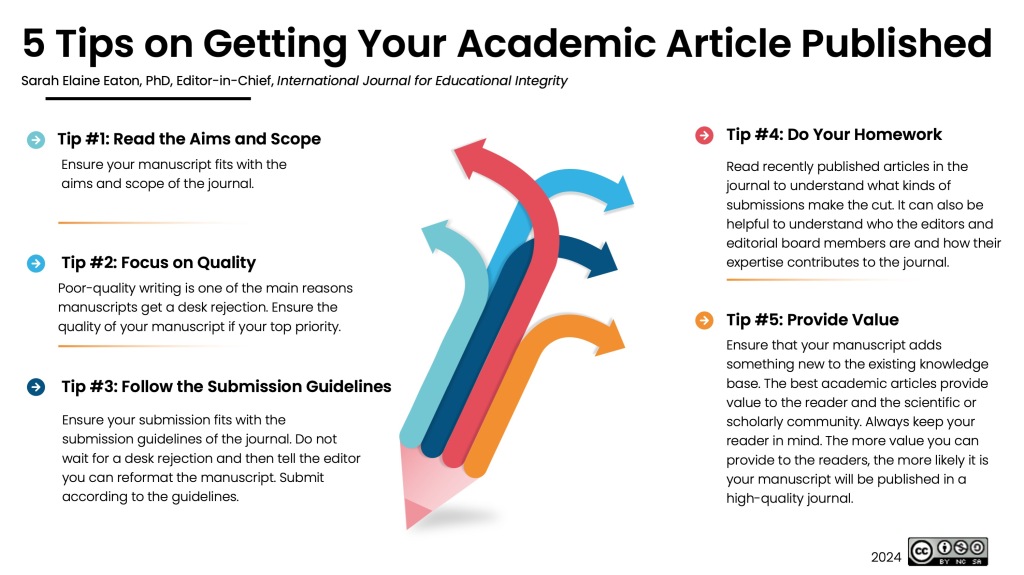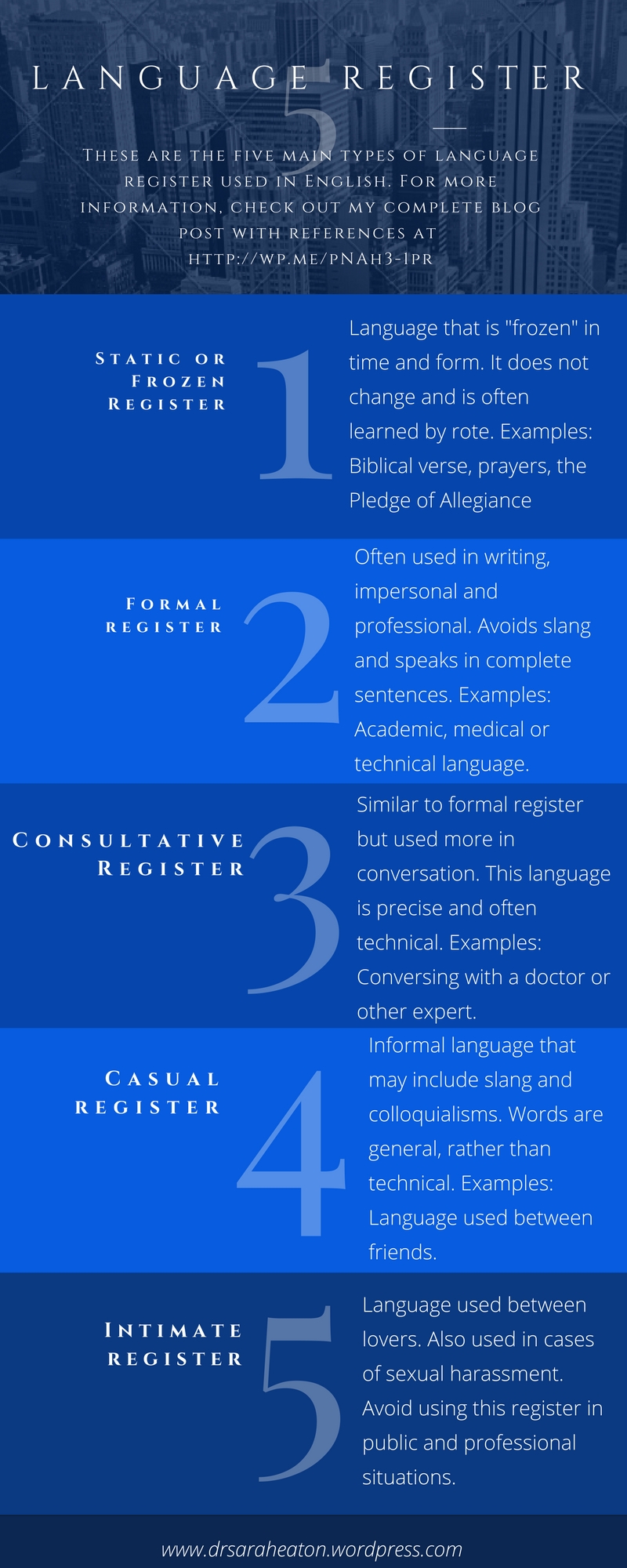
This month marks the beginning of my fourth year as editor-in-chief of the International Journal for Educational Integrity. Before that I served as co-editor and before that, I served as a reviewer and article author. Last year, the journal received its first impact factor (4.6), putting it in the 95th percentile of all journals in the field of educational research. Since that happened, the number of submissions the journal has received seems to have skyrocketed. Every week I am reviewing submissions from authors eager to have their work published in a Q1 (top quartile) academic journal. In this post I offer five tips on how to get your work published in a top-ranking journal.
Tip #1: Read the Aims and Scope
Ensure your manuscript fits with the aims and scope of the journal. The number one reason I reject manuscripts outright without sending them for peer review is that the topic of the manuscript has no relevance whatsoever to our journal. Reputable journals publish their aims and scope on their website. As an example, here are the Aims and Scope of the International Journal for Educational Integrity.
As an interdisciplinary journal, we receive submissions from just about every academic field you can imagine, but just because a journal is interdisciplinary does not mean that anything goes. When I get a manuscript about the efficacy rates of a pesticide or new developments related to geo-spatial heat maps, I reject it automatically because the topic is outside the scope of our journal. Manuscripts that are about education broadly, but that have no direct connection to ethics and integrity, also get a desk rejection.
If you want to publish your article in a high quality journal, ensure it aligns with the aims and scope of the journal.
Tip #2: Focus on Quality
Poor-quality writing is one of the main reasons manuscripts get a desk rejection. Ensure the quality of your manuscript is your top priority. Markers of quality include, but are not limited to, writing that is comprehensible and error-free. (The odd typo can be fixed during the revision process.) Quality also means including a literature review that demonstrates that you understand previous scholarship in the field, a detailed methods section, and an in-depth analysis. The findings should show original contributions to the field, along with the limitations of the work.
Articles that are theoretical or conceptual in nature should still have a clear structure and be organized in a way that the reader can follow. The problem/gap/hook heuristic is one way to frame a conceptual article so that the value to the reader is clear.
Submissions that are difficult to read, either because of poor writing or because they lack organization, are more likely to be rejected. This does not mean that all articles have to follow a cookie-cutter formula. Unconventional articles can be interesting and valuable, but the reader still has to be able to follow them.
Tip #3: Follow the Submission Guidelines
Ensure your submission fits with the submission guidelines of the journal. Do not wait for a desk rejection and then tell the editor you can reformat the manuscript. Submit according to the guidelines.
I have had prospective authors argue with me via e-mail when I reject or request a revision to their submissions on the basis that their manuscript does not follow the journal’s guidelines. Arguing with an editor about how you do not have time or interest in submitting according to the journal’s guidelines is unlikely to persuade an editor that your submission should be reviewed. Saying that you will revise or reformat the submission only if your article is accepted is a fast track to a rejection.
Tip #4: Do Your Homework
Read recently published articles in the journal to understand what kinds of submissions make the cut. It can also be helpful to understand who the editors and editorial board members are and how their expertise contributes to the journal.
I reviewed a submission that claimed that female students were inherently prone to academic cheating because of their gender. (The main argument was that women are more morally corrupt than men.) Um…. Pardon me?!
Needless to say that the submission was problematic (and rejected) for a number of reasons, not the least of which was a lack of scientific basis for the claims made in the submission. As I conducted my preliminary editorial review, it occurred to me that the authors probably had no idea that the editor was a woman… And why would they, when only 8% of editors-in-chief of academic journals are women? It might not have even occurred to them to check. (If they had, they could have saved themselves the trouble of submitting…)
A quick check of the Editorial Board can give you a glimpse into who provides leadership for a journal. Reviewing the information about the editorial board is likely to provide an incomplete picture at best, but it can be helpful.
Tip #5: Provide Value
Ensure that your manuscript adds something new to the existing knowledge base. The best academic articles provide value to the reader and the wider scientific or scholarly community. Always keep your reader in mind. One reason submissions get rejected is that the authors are so self-absorbed in themselves and their own ideas or goals is that they fail to consider individual readers as well as the collective readership of the journal as a whole.
When prospective authors beg me to publish their article because they need a publication to graduate, get hired, keep their jobs, or get promoted, my heart aches. This is a sign of systemic dysfunction of academia in general, but it is a one that a journal editor cannot solve. The article itself must provide value to the reader or the piece is unlikely to get published. The more value you can provide to the readers, the more likely it is your manuscript will be published in a high-quality journal.
There are lots of other things to say about how to get your work published in a high-quality academic journal, but I’ll stop for now, as this covers some of the basics. I hope these tips are helpful for getting your academic work published in the coming year(s).
____________________________
Share this post: How to Get Your Academic Article Published in a High Quality Journal – https://drsaraheaton.wordpress.com/2024/01/02/how-to-get-your-academic-article-published-in-a-high-quality-journal/
This blog has had over 3 million views thanks to readers like you. If you enjoyed this post, please “like” it or share it on social media. Thanks!
Sarah Elaine Eaton, PhD, is a faculty member in the Werklund School of Education at the University of Calgary, Canada. Opinions are my own and do not represent those of my employer.
Sarah Elaine Eaton, PhD, Editor-in-Chief, International Journal for Educational Integrity



 Posted by Sarah Elaine Eaton, Ph.D.
Posted by Sarah Elaine Eaton, Ph.D. 



You must be logged in to post a comment.